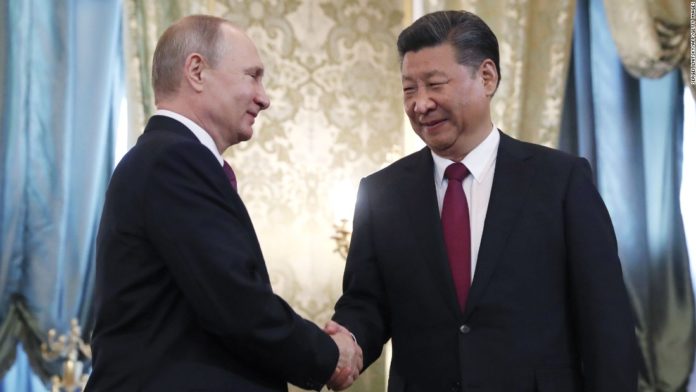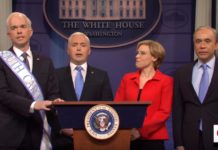And as if this were not enough to send shivers through American strategic planners, Iran has now announced that it will be joining Russia and China for joint, month-long military exercises in the northern Indian Ocean starting December 22.
The gas pipeline project itself brings together America’s two leading adversaries, who at one time were utterly at odds with each other, but who have been driven closer than at any time in their history by domestic and international circumstances. In a joint teleconference inaugurating the project, Russian President Vladimir Putin characterized it as a “genuinely historical event….for us, for Russia and China.” The pipeline, he continued, “takes Russia-China energy cooperation to a whole new level and brings us closer to achieving the goal set together with Chinese President Xi Jinping of extending bilateral trade turnover to $200 billion in 2024.”
Not to be outdone, Chinese President Xi Jinping dubbed the launch “the start of a new stage of our co-operation.” But of even greater concern should be the Chinese leader’s insistence that the pipeline is the most tangible evidence of an “all-encompassing partnership and strategic co-operation entering a new epoch.” And he agreed that “developing Russia-China relations is and will be a priority in our countries’ foreign policy.”
Indeed, there are other similar projects already under discussion—a Power of Siberia 2, to deliver 30 billion cubic meters a year of gas to the western border of China it shares with Russia and a smaller pipeline from Sakhalin Island in extreme eastern Siberia, according to the Financial Times.
It wasn’t always this way between these two neighboring communist nations. Indeed, it was not so very long ago that the USSR feared communist Chinese groups pouring across the border, sweeping through the Soviet Union much as descendants of Genghis Khan had done seven centuries before. For several months in 1969 there was a hot border war, with Moscow even considering a pre-emptive nuclear strike on China. To this day, China and Russia, as well as its longtime satellite Mongolia, still have different rail gauges on their railway systems so that trains entering China need to have their undercarriages swapped at the border.
Now, both nations are increasingly being tied together by economic and political issues they are confronting in dealing with America and the West. Each is seeking alternatives to European and American markets. Russia remains hobbled by Western sanctions over its seizure of Crimea from Ukraine and its continued armed efforts to take control over the Donbas region of eastern Ukraine. China remains enmeshed in a bitter trade and tariff war with the United States.
With this new reality of a strengthening partnership of two nations that together comprise 10.3 million square miles, about three times the size of the United States, and 1.58 billion people or nearly 20% of the world’s population, the combined power of their markets, production output, natural resources, not to mention their military might, are formidable. Indeed, if properly directed, this power could effectively neutralize much of the impact of sanctions or escalating tariffs.
Just where could such a massive concentration of power go? China would certainly be in a position to continue expansion of its Belt and Road initiative, once a counterweight to Barack Obama’s Trans-Pacific Partnership trade pact that has languished in the Trump era. At the same time Russia is seeking a means of accumulating more western currency, particularly dollars, for the oil and gas resources that are the backbone of its economy. And both Russia and China are seeking a united counterweight in political and military terms to the West, especially the United States.
In June, during in a three-day state visit to Russia, Chinese President Xi Jinping called Putin his “best friend,” an ominous sign of a potential partnership to come. This followed two successive massive joint military exercises involving the armies of both nations last year and again this year with hundreds of thousands of military personnel. This year’s Tsentr 2019 exercises also included military forces from India and Pakistan as well as Russian client states Kazakhstan, Kyrgyzstan, Tajikistan and Uzbekistan. That Russia and China were able to attract traditionally hostile Indian and Pakistani military forces, which have so often in past years chosen up opposite sides in any China-Russian competition, is even more ominous.
Such a growing China-Russia condominium is being put very much to the test this week at the NATO summit in London marking the alliance’s 70th birthday. Here, President Trump appears to be seeking to persuade NATO that it is China that is the alliance’s principal challenge rather than longtime foe Russia. Some NATO members, especially French President Emmanuel Macron, may be reluctant to go along.
“China has become very powerful and much more so than in the past,” Trump said in an opening session with reporters in London alongside NATO Secretary General Jens Stoltenberg, who added that “China is now the second-largest defense spender in the world, after the United States.” Which is not to say that NATO has any intention of abandoning its longtime focus on Russia as a primary competitor, if not foe.
Still, the United States must learn to cope with this new geopolitical reality of a dual, and increasingly united set of antagonists. Sadly, not everyone has learned this lesson. “Russia is not America’s main enemy, obviously,” Tucker Carlson told his millions of viewers on Fox this week. “No sane person thinks it is. Our main enemy, of course, is China. And the US ought to be in a relationship with Russia aligned against China.”
Clearly, there seems to be little intention on the parts of Russia or China to abandon their dash toward a toxic détente. At the same time, it is hardly too early for the United States and its allies to begin confronting the reality of this new friendship.
Source : Nbcnewyork











